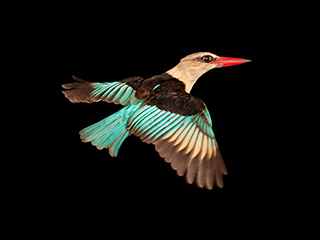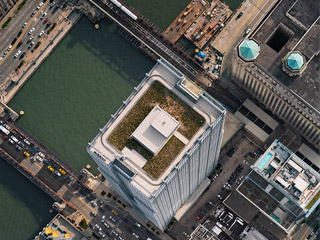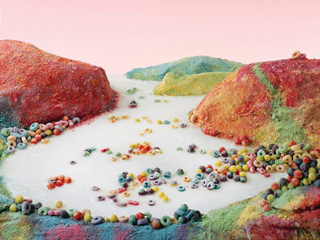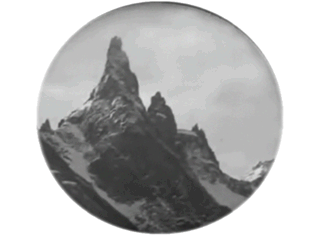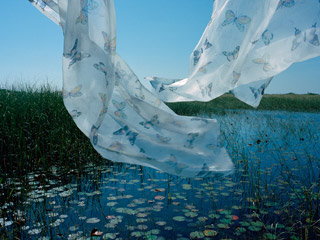Vanessa Alcaíno & Alejandro Malo
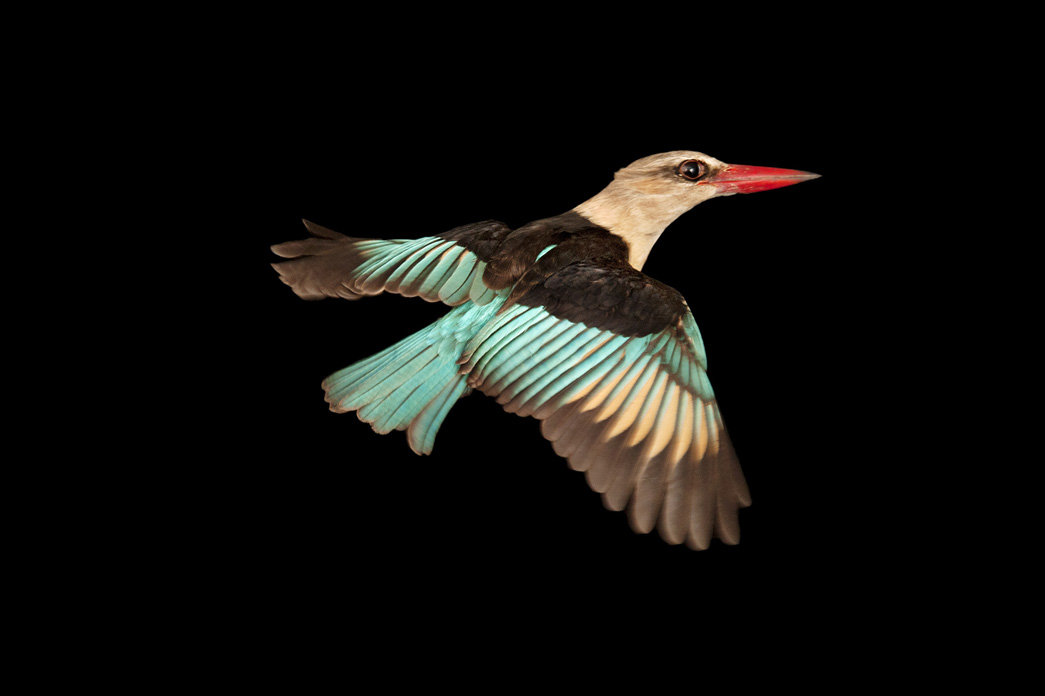
Brown Hooded Kingfisher, (Halcyon albiventris), Chitengo Camp, Gorongosa National Park, Mozambique, 2011. By Joel Sartore
When we choose to address a landscape issue and, soon after, we realized its relationship with the theme of the FotoFest 2016 Biennial: Changing Circumstances: Looking at the Future of the Planet, we thought it appropriate to echo the concerns expressed during the festival. A few contents presented in this issue offer a digital version of the same exhibitions for our audience. However, this observation would be insufficient without emphasizing some of the ideas included in the book of the same name that drives us to insist on the invitation to peer into its pages.
Conceived as a collaboration between Frederick Baldwin and Wendy Watriss, founders of FotoFest, with Steven Evans, Executive Director of the festival, it integrates a diverse and broad mosaic of artists. In his introductory text, Steven Evans highlights the need to promote the exchange of ideas between artists who use different strategies to address the issue. It also contrast the divergence of gazes with the unifying leitmotif of Thomas E. Lovejoy and Geof Rayner essays that show an intrinsic connection between all artist’s concerns. Both essays provide strong arguments on the urgent need for action on climate change; the first, from the perspective of the Earth as a living organism, and the second by demonstrating the decisive role of human beings in their environment.
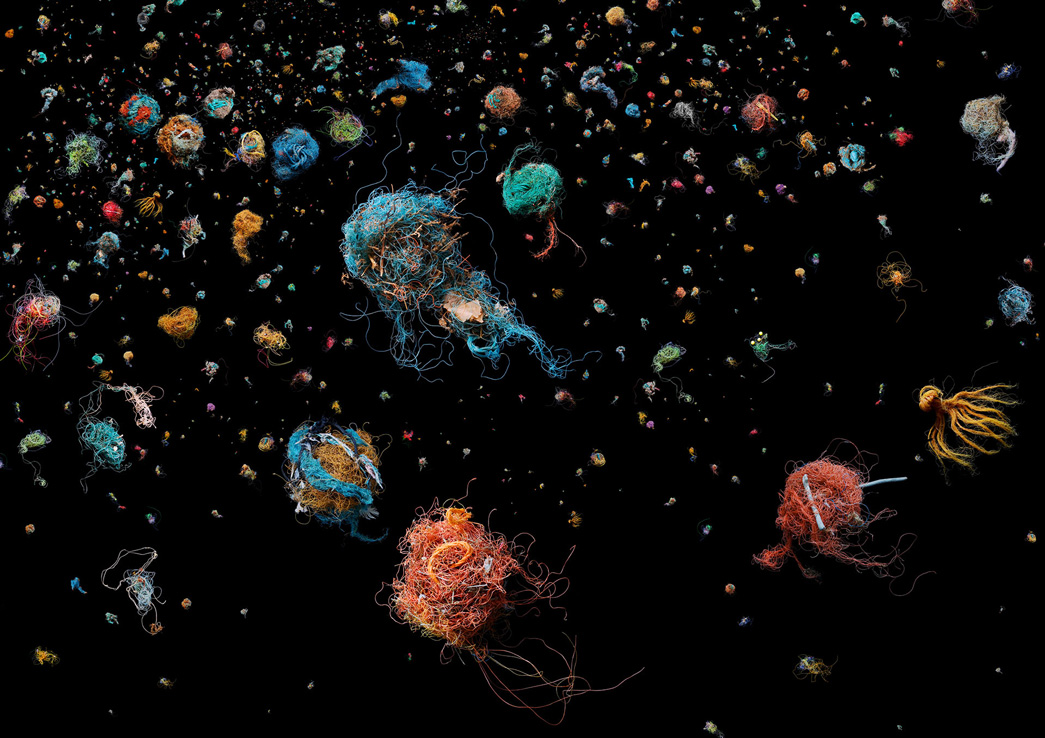
Bird’s Nest, 2011. Por Mandy Barker
Finally, Wendy Watriss gives voice to some questions that resonate with concerns we encountered during our research on the theme of landscape: "We have responsibility not only for our own well-being but that of the rest of the natural world? Can art stimulate new perspectives and new ways of seeing?” Photography has in its hands the potential to share with us realities that otherwise would be inaccessible. The images are not neutral, they feed imagination and foster reflections, being a very effective means to make any problem palpable, visible and close, to the point of being able to bring them into the political sphere and encourage agreements. We agree with Wendy’s view that art can itself stimulate and expand our world view and present innovative ways to address the issue of climate change. We should not allow ourselves to have skewed visions that only address and speak from a knowledge area or a region of the world. We must open to different cultures, include divergent views, draw new and different boundaries, create unique maps, put the world upside down, stir and divide it in various ways. That is the only way to visualize a future where rather than dominate nature, we can collaborate for its survival and ours. And this way of ‘seeing’ the world, and the new paths to our future, is what art may best express.
 Vanessa Alcaíno Pizani (Venezuela, 1980). Lives and works in Mexico. Visual artist. She graduated in Philosophy at the Central University of Venezuela and has a Master’s degree in Spanish and Latin American Thought at the Autonomous University of Madrid (UAM). Since 1994, she has worked in the field of photography at various institutions and organisations in Venezuela, Argentina and Mexico. At the moment, she is part of the editorial team of zonezero.com.
Vanessa Alcaíno Pizani (Venezuela, 1980). Lives and works in Mexico. Visual artist. She graduated in Philosophy at the Central University of Venezuela and has a Master’s degree in Spanish and Latin American Thought at the Autonomous University of Madrid (UAM). Since 1994, she has worked in the field of photography at various institutions and organisations in Venezuela, Argentina and Mexico. At the moment, she is part of the editorial team of zonezero.com. Alejandro Malo (Mexico, 1972). Lives and works in Mexico and is the director of ZoneZero. Since 1993, he has taken part in various cultural projects and worked as an information technology consultant. He has collaborated in print and electronic publications, and given workshops and conferences on literature, creative writing, storytelling and technology. In 2009, Malo joined the team of the Fundación Pedro Meyer, where he directs the Archives and Technology departments.
Alejandro Malo (Mexico, 1972). Lives and works in Mexico and is the director of ZoneZero. Since 1993, he has taken part in various cultural projects and worked as an information technology consultant. He has collaborated in print and electronic publications, and given workshops and conferences on literature, creative writing, storytelling and technology. In 2009, Malo joined the team of the Fundación Pedro Meyer, where he directs the Archives and Technology departments.
Brown Hooded Kingfisher, (Halcyon albiventris), Chitengo Camp, Gorongosa National Park, Mozambique, 2011. By Joel Sartore
When we choose to address a landscape issue and, soon after, we realized its relationship with the theme of the FotoFest 2016 Biennial: Changing Circumstances: Looking at the Future of the Planet, we thought it appropriate to echo the concerns expressed during the festival. A few contents presented in this issue offer a digital version of the same exhibitions for our audience. However, this observation would be insufficient without emphasizing some of the ideas included in the book of the same name that drives us to insist on the invitation to peer into its pages.
Conceived as a collaboration between Frederick Baldwin and Wendy Watriss, founders of FotoFest, with Steven Evans, Executive Director of the festival, it integrates a diverse and broad mosaic of artists. In his introductory text, Steven Evans highlights the need to promote the exchange of ideas between artists who use different strategies to address the issue. It also contrast the divergence of gazes with the unifying leitmotif of Thomas E. Lovejoy and Geof Rayner essays that show an intrinsic connection between all artist’s concerns. Both essays provide strong arguments on the urgent need for action on climate change; the first, from the perspective of the Earth as a living organism, and the second by demonstrating the decisive role of human beings in their environment.

Bird’s Nest, 2011. Por Mandy Barker
Finally, Wendy Watriss gives voice to some questions that resonate with concerns we encountered during our research on the theme of landscape: "We have responsibility not only for our own well-being but that of the rest of the natural world? Can art stimulate new perspectives and new ways of seeing?” Photography has in its hands the potential to share with us realities that otherwise would be inaccessible. The images are not neutral, they feed imagination and foster reflections, being a very effective means to make any problem palpable, visible and close, to the point of being able to bring them into the political sphere and encourage agreements. We agree with Wendy’s view that art can itself stimulate and expand our world view and present innovative ways to address the issue of climate change. We should not allow ourselves to have skewed visions that only address and speak from a knowledge area or a region of the world. We must open to different cultures, include divergent views, draw new and different boundaries, create unique maps, put the world upside down, stir and divide it in various ways. That is the only way to visualize a future where rather than dominate nature, we can collaborate for its survival and ours. And this way of ‘seeing’ the world, and the new paths to our future, is what art may best express.
 Vanessa Alcaíno Pizani (Venezuela, 1980). Lives and works in Mexico. Visual artist. She graduated in Philosophy at the Central University of Venezuela and has a Master’s degree in Spanish and Latin American Thought at the Autonomous University of Madrid (UAM). Since 1994, she has worked in the field of photography at various institutions and organisations in Venezuela, Argentina and Mexico. At the moment, she is part of the editorial team of zonezero.com.
Vanessa Alcaíno Pizani (Venezuela, 1980). Lives and works in Mexico. Visual artist. She graduated in Philosophy at the Central University of Venezuela and has a Master’s degree in Spanish and Latin American Thought at the Autonomous University of Madrid (UAM). Since 1994, she has worked in the field of photography at various institutions and organisations in Venezuela, Argentina and Mexico. At the moment, she is part of the editorial team of zonezero.com. Alejandro Malo (Mexico, 1972). Lives and works in Mexico and is the director of ZoneZero. Since 1993, he has taken part in various cultural projects and worked as an information technology consultant. He has collaborated in print and electronic publications, and given workshops and conferences on literature, creative writing, storytelling and technology. In 2009, Malo joined the team of the Fundación Pedro Meyer, where he directs the Archives and Technology departments.
Alejandro Malo (Mexico, 1972). Lives and works in Mexico and is the director of ZoneZero. Since 1993, he has taken part in various cultural projects and worked as an information technology consultant. He has collaborated in print and electronic publications, and given workshops and conferences on literature, creative writing, storytelling and technology. In 2009, Malo joined the team of the Fundación Pedro Meyer, where he directs the Archives and Technology departments.Yang Yongliang





Artificial Wonderland is a series started in 2010. Yang Yongliang uses images of architecture as brushstrokes; heavy mountain rocks with enriched details draw a faithful reference to Song Dynasty landscape painting. Urban development makes life in the city flourish, but it also imprisons these lives; centuries-old cultural tradition in China is profound, but it has also remained stagnant. Ancient Chinese people painted landscapes to praise the greatness of nature; Yang's works, on the other hand, lead towards a critical re-thinking of contemporary reality.

















In Artificial Wonderland II (2014), there are digital replicas of two Song Dynasty master paintings, namely Travelers Among Mountains and Steams (Fan Kuan) and Wintery Forest in the Snow (anonymous). Whereas ancient landscapes are often seen as being without time, Yang's interpretation of the latter work is a nocturnal image, titled Wintery Forest in the Night. The 2014 series marks a step forward in terms of digital technique--the piece is larger than ever and enriched with tremendous detail images. Also, Yang conjucted natural mountain rocks into the signature artificial landscape for the first time. Images of the mountain rocks are mostly taken in Iceland and Norway. In 2015, Artificial Wonderland II was shortlisted in the Prix Pictet – the global award in photography and sustainability.
The Day of Perpetual Night and The Night of Perpetual Day, are two pieces that exemplify a line of recent video work by Yang Yongliang. In them, the traditional landscape extends a narrative between a subtle temporality and diffuse timelessness. With the same rigorous technique that characterizes his still images, in these videos he uses time as a tool to emphasize the paradox of our time: the crossroads between necessary nostalgia, our daily chaos and imagination.

The Night of Perpetual Day. Artwork preview here

The Day of Perpetual Night. Artwork preview here
 Yang Yongliang (Shanghai, 1980). He graduated from China Academy of Art in 2003, majored in visual communication. He started his experiments with contemporary art in 2005, and his practice involved varied media including photography, painting, video and installation. Yang exploits a connection between traditional art and the contemporary, implementing ancient oriental aesthetics and literati beliefs with modern language and digital techniques. His work as an expanding meta-narrative that draws from history, myth and social culture, and plays out in the context of the city and its ever-changing landscapes.
Yang Yongliang (Shanghai, 1980). He graduated from China Academy of Art in 2003, majored in visual communication. He started his experiments with contemporary art in 2005, and his practice involved varied media including photography, painting, video and installation. Yang exploits a connection between traditional art and the contemporary, implementing ancient oriental aesthetics and literati beliefs with modern language and digital techniques. His work as an expanding meta-narrative that draws from history, myth and social culture, and plays out in the context of the city and its ever-changing landscapes.




Artificial Wonderland is a series started in 2010. Yang Yongliang uses images of architecture as brushstrokes; heavy mountain rocks with enriched details draw a faithful reference to Song Dynasty landscape painting. Urban development makes life in the city flourish, but it also imprisons these lives; centuries-old cultural tradition in China is profound, but it has also remained stagnant. Ancient Chinese people painted landscapes to praise the greatness of nature; Yang's works, on the other hand, lead towards a critical re-thinking of contemporary reality.

















In Artificial Wonderland II (2014), there are digital replicas of two Song Dynasty master paintings, namely Travelers Among Mountains and Steams (Fan Kuan) and Wintery Forest in the Snow (anonymous). Whereas ancient landscapes are often seen as being without time, Yang's interpretation of the latter work is a nocturnal image, titled Wintery Forest in the Night. The 2014 series marks a step forward in terms of digital technique--the piece is larger than ever and enriched with tremendous detail images. Also, Yang conjucted natural mountain rocks into the signature artificial landscape for the first time. Images of the mountain rocks are mostly taken in Iceland and Norway. In 2015, Artificial Wonderland II was shortlisted in the Prix Pictet – the global award in photography and sustainability.
The Day of Perpetual Night and The Night of Perpetual Day, are two pieces that exemplify a line of recent video work by Yang Yongliang. In them, the traditional landscape extends a narrative between a subtle temporality and diffuse timelessness. With the same rigorous technique that characterizes his still images, in these videos he uses time as a tool to emphasize the paradox of our time: the crossroads between necessary nostalgia, our daily chaos and imagination.

The Night of Perpetual Day. Artwork preview here

The Day of Perpetual Night. Artwork preview here
 Yang Yongliang (Shanghai, 1980). He graduated from China Academy of Art in 2003, majored in visual communication. He started his experiments with contemporary art in 2005, and his practice involved varied media including photography, painting, video and installation. Yang exploits a connection between traditional art and the contemporary, implementing ancient oriental aesthetics and literati beliefs with modern language and digital techniques. His work as an expanding meta-narrative that draws from history, myth and social culture, and plays out in the context of the city and its ever-changing landscapes.
Yang Yongliang (Shanghai, 1980). He graduated from China Academy of Art in 2003, majored in visual communication. He started his experiments with contemporary art in 2005, and his practice involved varied media including photography, painting, video and installation. Yang exploits a connection between traditional art and the contemporary, implementing ancient oriental aesthetics and literati beliefs with modern language and digital techniques. His work as an expanding meta-narrative that draws from history, myth and social culture, and plays out in the context of the city and its ever-changing landscapes.Ellie Davies
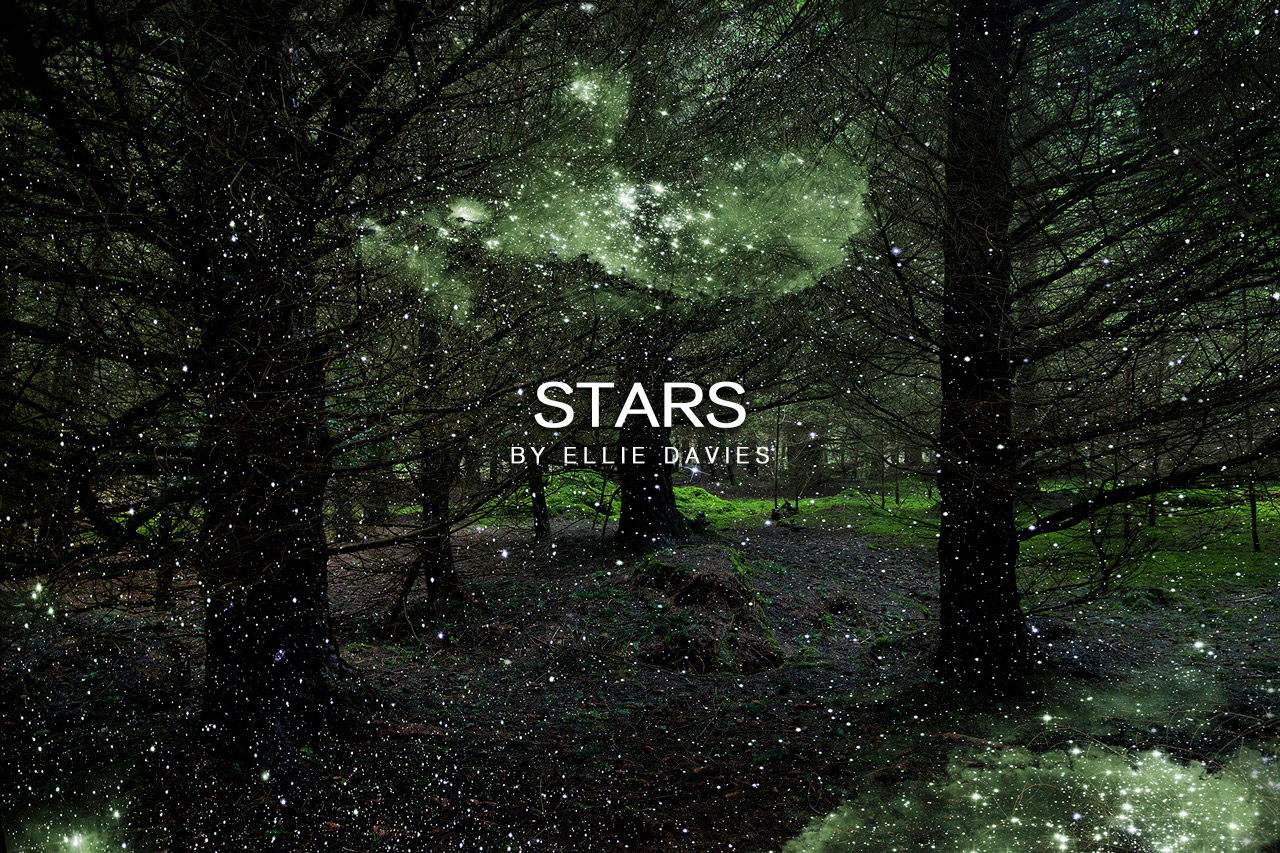
Stars, 2014 explores my desire to find some balance between a relationship with the wild places of my youth, and a pervasive sense of disconnectedness with the natural world.
The Western landscape tradition embodies a pairing that James Elkins calls ‘the subject-object relationship’. Typified by the ‘scenic viewpoint’ or tourist panoramic overlook, we gaze, often through binoculars or telescopes, at wide vistas and dramatic seascapes, awed and overwhelmed. But this landscape experience often alienates the viewer from the scene and, just as the landscape itself becomes an object, a separation arises between them.
Today the majority of people live in urban or semi-urban environments, experiencing the landscape from a distanced position mediated through various media and technology. From this viewpoint the notion of the landscape in all its sensuous materiality, our being within it rather than outside it, seems beyond reach.
Stars, 2014 addresses this distancing by drawing the viewer right into the heart of a forest which still holds mystery, and offers the potential for discovery and exploration. The series considers the fragility of our relationship with the natural world, and the temporal and finite nature of landscape as a human construct.
Mature and ancient forest landscapes are interposed with images of the Milky Way, Omega Centauri, the Norma Galaxy and Embryonic stars in the Nebula NGC 346 captured by the Hubble Telescope. Each image links forest landscapes with the intangible and unknown universe creating a juxtaposition that reflects my personal experiences of the forest; its physicality and tactility set against a profound and fundamental otherness, an alienation that separates us from a truly immersive relationship with the natural world.
(Source Material Credit: STScI/Hubble & NASA)















 Ellie Davies (England, 1976). Lives in London and works in the woods and forests of Southern England. She gained her MA in Photography from London College of Communication in 2008. She has recently been selected Landscape Winner in PDN’s The Curator Awards 2016. The six winning artists were exhibited at Foley Gallery in New York from 14 - 24 July 2016. Her Stars series was selected for the Aesthetica Art Prize 2016 and received The People Choice Award and has also been selected for exhibition at the Singapore International Photo Festival in October 2016. The Roe Valley Arts and Cultural Centre in Northern Ireland will host a solo exhibition of her images in April 2017.
Ellie Davies (England, 1976). Lives in London and works in the woods and forests of Southern England. She gained her MA in Photography from London College of Communication in 2008. She has recently been selected Landscape Winner in PDN’s The Curator Awards 2016. The six winning artists were exhibited at Foley Gallery in New York from 14 - 24 July 2016. Her Stars series was selected for the Aesthetica Art Prize 2016 and received The People Choice Award and has also been selected for exhibition at the Singapore International Photo Festival in October 2016. The Roe Valley Arts and Cultural Centre in Northern Ireland will host a solo exhibition of her images in April 2017.
Stars, 2014 explores my desire to find some balance between a relationship with the wild places of my youth, and a pervasive sense of disconnectedness with the natural world.
The Western landscape tradition embodies a pairing that James Elkins calls ‘the subject-object relationship’. Typified by the ‘scenic viewpoint’ or tourist panoramic overlook, we gaze, often through binoculars or telescopes, at wide vistas and dramatic seascapes, awed and overwhelmed. But this landscape experience often alienates the viewer from the scene and, just as the landscape itself becomes an object, a separation arises between them.
Today the majority of people live in urban or semi-urban environments, experiencing the landscape from a distanced position mediated through various media and technology. From this viewpoint the notion of the landscape in all its sensuous materiality, our being within it rather than outside it, seems beyond reach.
Stars, 2014 addresses this distancing by drawing the viewer right into the heart of a forest which still holds mystery, and offers the potential for discovery and exploration. The series considers the fragility of our relationship with the natural world, and the temporal and finite nature of landscape as a human construct.
Mature and ancient forest landscapes are interposed with images of the Milky Way, Omega Centauri, the Norma Galaxy and Embryonic stars in the Nebula NGC 346 captured by the Hubble Telescope. Each image links forest landscapes with the intangible and unknown universe creating a juxtaposition that reflects my personal experiences of the forest; its physicality and tactility set against a profound and fundamental otherness, an alienation that separates us from a truly immersive relationship with the natural world.
(Source Material Credit: STScI/Hubble & NASA)















 Ellie Davies (England, 1976). Lives in London and works in the woods and forests of Southern England. She gained her MA in Photography from London College of Communication in 2008. She has recently been selected Landscape Winner in PDN’s The Curator Awards 2016. The six winning artists were exhibited at Foley Gallery in New York from 14 - 24 July 2016. Her Stars series was selected for the Aesthetica Art Prize 2016 and received The People Choice Award and has also been selected for exhibition at the Singapore International Photo Festival in October 2016. The Roe Valley Arts and Cultural Centre in Northern Ireland will host a solo exhibition of her images in April 2017.
Ellie Davies (England, 1976). Lives in London and works in the woods and forests of Southern England. She gained her MA in Photography from London College of Communication in 2008. She has recently been selected Landscape Winner in PDN’s The Curator Awards 2016. The six winning artists were exhibited at Foley Gallery in New York from 14 - 24 July 2016. Her Stars series was selected for the Aesthetica Art Prize 2016 and received The People Choice Award and has also been selected for exhibition at the Singapore International Photo Festival in October 2016. The Roe Valley Arts and Cultural Centre in Northern Ireland will host a solo exhibition of her images in April 2017.Marcus DeSieno

Surveillance Landscapes interrogates how surveillance technology has changed our relationship and understanding of landscape and place in our increasingly intrusive electronic culture. I hack into surveillance cameras, public webcams, and CCTV feeds in a pursuit for the classical picturesque landscape, dislocating the visual product from its automated origins while searching for a conversation between land, borders, and power. The very act of surveying a site through these photographic systems implies a dominating relationship between man and place. Ultimately, I hope to undermine these schemes of social control through the obfuscated melancholic images found while exploiting the technological mechanisms of power in our surveillance society.




















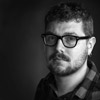 Marcus DeSieno (USA). His work is concerned with science and exploration in relation to the history of photography. He received his MFA in Studio Art from the University of South Florida in 2015. DeSieno often assumes the role of the amateur scientist in his work in order to investigate photography's historic relationship with science in regards to the notion of the invisible. Antiquated and obsolescent photographic processes are often combined with contemporary imaging technologies to engage in a critical dialog on the evolution of photographic technology in relation to seeing.
Marcus DeSieno (USA). His work is concerned with science and exploration in relation to the history of photography. He received his MFA in Studio Art from the University of South Florida in 2015. DeSieno often assumes the role of the amateur scientist in his work in order to investigate photography's historic relationship with science in regards to the notion of the invisible. Antiquated and obsolescent photographic processes are often combined with contemporary imaging technologies to engage in a critical dialog on the evolution of photographic technology in relation to seeing.
Surveillance Landscapes interrogates how surveillance technology has changed our relationship and understanding of landscape and place in our increasingly intrusive electronic culture. I hack into surveillance cameras, public webcams, and CCTV feeds in a pursuit for the classical picturesque landscape, dislocating the visual product from its automated origins while searching for a conversation between land, borders, and power. The very act of surveying a site through these photographic systems implies a dominating relationship between man and place. Ultimately, I hope to undermine these schemes of social control through the obfuscated melancholic images found while exploiting the technological mechanisms of power in our surveillance society.




















 Marcus DeSieno (USA). His work is concerned with science and exploration in relation to the history of photography. He received his MFA in Studio Art from the University of South Florida in 2015. DeSieno often assumes the role of the amateur scientist in his work in order to investigate photography's historic relationship with science in regards to the notion of the invisible. Antiquated and obsolescent photographic processes are often combined with contemporary imaging technologies to engage in a critical dialog on the evolution of photographic technology in relation to seeing.
Marcus DeSieno (USA). His work is concerned with science and exploration in relation to the history of photography. He received his MFA in Studio Art from the University of South Florida in 2015. DeSieno often assumes the role of the amateur scientist in his work in order to investigate photography's historic relationship with science in regards to the notion of the invisible. Antiquated and obsolescent photographic processes are often combined with contemporary imaging technologies to engage in a critical dialog on the evolution of photographic technology in relation to seeing.Rasel Chowdhury

When we are celebrating 400 years of Dhaka City, River Buriganga is fighting to survive. Today, it is nearly dead, can’t run on its natural way. It seems that people of Dhaka are killing the river for their insensitivity.
In Dhaka, people are growing day by day. Working places and various factories are booming constantly. Buriganga River is the one of the most popular way to communicate with another part of the country. Millions of people use the river everyday for bearing their various goods.
Tannery chemical, Mans wastage of whole Dhaka City and Industrial Wastage chemicals directly go down in Buriganga River. Nearly 700 brickfields on the riverside, dockyards and Barn oil from the boats and steamers are the causes of pollution.
This 41 km long river once blessed us with hope and dream to build a new city. But today, the city itself is a cause for the death of Buriganga. We, the Citizens of Dhaka are going to destroy our own river!
As a photographer, I see my role in my engagement with own city. I have an intrinsic relationship with this city and river as I spent most of my life in and around them. As a documentary photographer, my approach was to show the river and its rapidly changing landscape in every possible angle. I explored several corners of the river to have a big picture on people’s destructive involvement. At the same time, divine water of the river, stands alone with its new wave of hope. I just tried to capture all the aspects for a greater concern.

















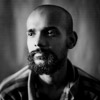 Rasel Chowdhury (Bangladesh, 1988). A documentary photographer. Rasel started photography without a conscious plan, eventually became addicted and decided to document spaces in and around his birthplace, Bangladesh. He obtained his graduation in photography from Pathshala, South Asian Media Institute, and in due course, he found the changing landscapes and environmental issues as few extremely important subjects to document in his generation. Rasel started documenting a dyeing river Buriganga, a dying city Sonargaon, Old People Home, Flood in Bangladesh, Mega City Dhaka and newly transformed spaces around Bangladesh railway to explore the change of the environment, unplanned urban structures and the new form of landscapes.
Rasel Chowdhury (Bangladesh, 1988). A documentary photographer. Rasel started photography without a conscious plan, eventually became addicted and decided to document spaces in and around his birthplace, Bangladesh. He obtained his graduation in photography from Pathshala, South Asian Media Institute, and in due course, he found the changing landscapes and environmental issues as few extremely important subjects to document in his generation. Rasel started documenting a dyeing river Buriganga, a dying city Sonargaon, Old People Home, Flood in Bangladesh, Mega City Dhaka and newly transformed spaces around Bangladesh railway to explore the change of the environment, unplanned urban structures and the new form of landscapes.
When we are celebrating 400 years of Dhaka City, River Buriganga is fighting to survive. Today, it is nearly dead, can’t run on its natural way. It seems that people of Dhaka are killing the river for their insensitivity.
In Dhaka, people are growing day by day. Working places and various factories are booming constantly. Buriganga River is the one of the most popular way to communicate with another part of the country. Millions of people use the river everyday for bearing their various goods.
Tannery chemical, Mans wastage of whole Dhaka City and Industrial Wastage chemicals directly go down in Buriganga River. Nearly 700 brickfields on the riverside, dockyards and Barn oil from the boats and steamers are the causes of pollution.
This 41 km long river once blessed us with hope and dream to build a new city. But today, the city itself is a cause for the death of Buriganga. We, the Citizens of Dhaka are going to destroy our own river!
As a photographer, I see my role in my engagement with own city. I have an intrinsic relationship with this city and river as I spent most of my life in and around them. As a documentary photographer, my approach was to show the river and its rapidly changing landscape in every possible angle. I explored several corners of the river to have a big picture on people’s destructive involvement. At the same time, divine water of the river, stands alone with its new wave of hope. I just tried to capture all the aspects for a greater concern.

















 Rasel Chowdhury (Bangladesh, 1988). A documentary photographer. Rasel started photography without a conscious plan, eventually became addicted and decided to document spaces in and around his birthplace, Bangladesh. He obtained his graduation in photography from Pathshala, South Asian Media Institute, and in due course, he found the changing landscapes and environmental issues as few extremely important subjects to document in his generation. Rasel started documenting a dyeing river Buriganga, a dying city Sonargaon, Old People Home, Flood in Bangladesh, Mega City Dhaka and newly transformed spaces around Bangladesh railway to explore the change of the environment, unplanned urban structures and the new form of landscapes.
Rasel Chowdhury (Bangladesh, 1988). A documentary photographer. Rasel started photography without a conscious plan, eventually became addicted and decided to document spaces in and around his birthplace, Bangladesh. He obtained his graduation in photography from Pathshala, South Asian Media Institute, and in due course, he found the changing landscapes and environmental issues as few extremely important subjects to document in his generation. Rasel started documenting a dyeing river Buriganga, a dying city Sonargaon, Old People Home, Flood in Bangladesh, Mega City Dhaka and newly transformed spaces around Bangladesh railway to explore the change of the environment, unplanned urban structures and the new form of landscapes.Júlia Pontés

Brazil is facing the largest environmental disaster in its history. Due the lack of specific regulations and low inspection, a mining company’s dam broke throwing 10.5 billion gallons of mud on one of the countries most important rivers and water sheds, covering a whole town and leaving many cities without water.
That breakage served as a groundbreaking for me. While flying over the area I was impressed by the landscape damaged that has been caused by the highly intensive mining activity in the state. Many of the open air mines, are hidden between the state of Minas Gerais’ “mountain” chains , therefore, local population has no sight of its extension. Most of the photographs were taken in a forbidden aerial space, with the plane’s transponder being off.
It is a very delicate subject, mining is the main industry in the state and it is so deeply routed that it is on it’s name. Everyone has a relation to the activity. My family had an iron processing company, one of the multiple stages on the mining commercial chain.
There is a mining regulation bill currently being discussed by Brazilian congressman. 20 out of the 27 congressman responsible for the project received money from mining companies to their campaigns.
This ongoing project is a landscape investigation both of the disaster, the unbounded and poorly regulated use of the soil.




















 Júlia Pontés (Brazil, 1983).Porteña by choice - Live & work in New York Her interests are influenced by Psychology and Public Policies, in which she holds a Master’s Degree. She graduated at the International Center of Photography and she has been chosen as an Emerging Immigrant Artist by the New York Foundation for the Arts, where she has been a mentee twice. She has a polarized practice that involves documenting stories linked to her own life experiences and, on the other hand, a self portraiture practice. In both she applies experimental techniques, the use of different mediums and archive material.
Júlia Pontés (Brazil, 1983).Porteña by choice - Live & work in New York Her interests are influenced by Psychology and Public Policies, in which she holds a Master’s Degree. She graduated at the International Center of Photography and she has been chosen as an Emerging Immigrant Artist by the New York Foundation for the Arts, where she has been a mentee twice. She has a polarized practice that involves documenting stories linked to her own life experiences and, on the other hand, a self portraiture practice. In both she applies experimental techniques, the use of different mediums and archive material.
Brazil is facing the largest environmental disaster in its history. Due the lack of specific regulations and low inspection, a mining company’s dam broke throwing 10.5 billion gallons of mud on one of the countries most important rivers and water sheds, covering a whole town and leaving many cities without water.
That breakage served as a groundbreaking for me. While flying over the area I was impressed by the landscape damaged that has been caused by the highly intensive mining activity in the state. Many of the open air mines, are hidden between the state of Minas Gerais’ “mountain” chains , therefore, local population has no sight of its extension. Most of the photographs were taken in a forbidden aerial space, with the plane’s transponder being off.
It is a very delicate subject, mining is the main industry in the state and it is so deeply routed that it is on it’s name. Everyone has a relation to the activity. My family had an iron processing company, one of the multiple stages on the mining commercial chain.
There is a mining regulation bill currently being discussed by Brazilian congressman. 20 out of the 27 congressman responsible for the project received money from mining companies to their campaigns.
This ongoing project is a landscape investigation both of the disaster, the unbounded and poorly regulated use of the soil.




















 Júlia Pontés (Brazil, 1983).Porteña by choice - Live & work in New York Her interests are influenced by Psychology and Public Policies, in which she holds a Master’s Degree. She graduated at the International Center of Photography and she has been chosen as an Emerging Immigrant Artist by the New York Foundation for the Arts, where she has been a mentee twice. She has a polarized practice that involves documenting stories linked to her own life experiences and, on the other hand, a self portraiture practice. In both she applies experimental techniques, the use of different mediums and archive material.
Júlia Pontés (Brazil, 1983).Porteña by choice - Live & work in New York Her interests are influenced by Psychology and Public Policies, in which she holds a Master’s Degree. She graduated at the International Center of Photography and she has been chosen as an Emerging Immigrant Artist by the New York Foundation for the Arts, where she has been a mentee twice. She has a polarized practice that involves documenting stories linked to her own life experiences and, on the other hand, a self portraiture practice. In both she applies experimental techniques, the use of different mediums and archive material.Brad Temkin

Most of my career has focused on our relationship with nature. I’m interested in how we find ways to accommodate nature, and how it accommodates us. As with most bodies of work, the pictures define my intent. But in the end, I make the pictures I do because of the conversation that occurs between the subject and myself - and this always depends on the light, the weather, how I'm feeling and what I am open to seeing at the moment. It's the moment all things come together for me.
Rooftop draws poetic attention to celebrate and proliferate new ideas in design showing the inventiveness in architecture and accommodating our need for nature. Green roofs reduce our carbon footprint by countering heat island effect and improve storm water control, but they do far more. These pictures symbolize the allure of nature in the face of our continuing urban sprawl. By securely situating the gardens within the steel, stone, and glass rectangularity of urban and industrial buildings, I ask viewers to revel in the far more open patterns, colors, and connection to the sky; and how they become part of a new landscape as well as a framework for positive change. Our ingenuity and grace continues to impress me. It makes me more optimistic about humanity.


















 Brad Temkin (USA, 1956). Has been documenting the human impact on the landscape. He has exhibited his photographs in museums and galleries throughout the United States and abroad. Temkin’s works are included in numerous permanent collections, including those of The Art Institute of Chicago; Milwaukee Art Museum; Corcoran Gallery of Art, Washington, D.C.; Museum of Fine Arts, Houston; Akron Art Museum, Ohio; and Museum of Contemporary Photography, Chicago, among others. His images have appeared in such publications as Aperture, Black & White Magazine, TIME Magazine and European Photography.
Brad Temkin (USA, 1956). Has been documenting the human impact on the landscape. He has exhibited his photographs in museums and galleries throughout the United States and abroad. Temkin’s works are included in numerous permanent collections, including those of The Art Institute of Chicago; Milwaukee Art Museum; Corcoran Gallery of Art, Washington, D.C.; Museum of Fine Arts, Houston; Akron Art Museum, Ohio; and Museum of Contemporary Photography, Chicago, among others. His images have appeared in such publications as Aperture, Black & White Magazine, TIME Magazine and European Photography.
Most of my career has focused on our relationship with nature. I’m interested in how we find ways to accommodate nature, and how it accommodates us. As with most bodies of work, the pictures define my intent. But in the end, I make the pictures I do because of the conversation that occurs between the subject and myself - and this always depends on the light, the weather, how I'm feeling and what I am open to seeing at the moment. It's the moment all things come together for me.
Rooftop draws poetic attention to celebrate and proliferate new ideas in design showing the inventiveness in architecture and accommodating our need for nature. Green roofs reduce our carbon footprint by countering heat island effect and improve storm water control, but they do far more. These pictures symbolize the allure of nature in the face of our continuing urban sprawl. By securely situating the gardens within the steel, stone, and glass rectangularity of urban and industrial buildings, I ask viewers to revel in the far more open patterns, colors, and connection to the sky; and how they become part of a new landscape as well as a framework for positive change. Our ingenuity and grace continues to impress me. It makes me more optimistic about humanity.


















 Brad Temkin (USA, 1956). Has been documenting the human impact on the landscape. He has exhibited his photographs in museums and galleries throughout the United States and abroad. Temkin’s works are included in numerous permanent collections, including those of The Art Institute of Chicago; Milwaukee Art Museum; Corcoran Gallery of Art, Washington, D.C.; Museum of Fine Arts, Houston; Akron Art Museum, Ohio; and Museum of Contemporary Photography, Chicago, among others. His images have appeared in such publications as Aperture, Black & White Magazine, TIME Magazine and European Photography.
Brad Temkin (USA, 1956). Has been documenting the human impact on the landscape. He has exhibited his photographs in museums and galleries throughout the United States and abroad. Temkin’s works are included in numerous permanent collections, including those of The Art Institute of Chicago; Milwaukee Art Museum; Corcoran Gallery of Art, Washington, D.C.; Museum of Fine Arts, Houston; Akron Art Museum, Ohio; and Museum of Contemporary Photography, Chicago, among others. His images have appeared in such publications as Aperture, Black & White Magazine, TIME Magazine and European Photography.Pedro David

Brazillian country side is being filled with eucalyptus.
The accelerated industrial development and the overtuned importance of steel exportation, lead by sucessive governments, are one of the reasons of the deforestation of the Cerrado, the Brazillian savana, the Atlantic Forest, and even the Amazon.
Several international steel companies, established by the country, buys large portions of land and substitutes the natural vegetation by transgenic eucalyptus trees, a fast growing kind of wood, used to make vegetal coal, an important ingredient in the tranformation of the iron ore to steel.
The eucalyptus charges high the environment for it’s fast growing speed: it consumes too much water and nutrients, leaving the soil exhausted and dry.
I’m working in some regions affected by these monocrops since my beginning as a photographer. The extensive and visually growing areas of the eucaliptus fields always concerned me, because of the environmental and also social impact it brings, changing the landscape as a whole, the geographical references, the natural resources, the economical activities, and the amount of water, now a global issue. I’ve ridden, and walked, a lot inside these fields since 2002.
I’ve photographed several situations trying to discuss this question in the last 13 years. But when, in a recent travel, I passed by road swallowed by an enormous eucaliptus field, I faced one of this hybrid scenes and saw the opportunity to make a representative image of the situation, a straight photograph containing: the past, a native tree, something that is desappearing of those landscapes, the future: those supra-vegetal, eucaliptus clones, in the present of the photography.
Besides this documentary facet, that is being effective to sensibilize people of the problem of the extensive growing of this and other kinds of monocrops, a basic Brazillian problem, I also see this work in a simbolic way. I note that people feel something beyond the direct meaning of these photographs, something like a direct identification with these encaged lifes, struggling to survive in an artificial, oppressive and vanishing world.


















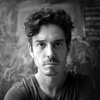 Pedro David (Brazil, 1977). He graduated in journalism in 2002. His works are in public and private photographic collections. He has received the Situações Brasília Contemporary Art Prize in 2012 and 2014; Conrado Wessel Foundation Prize of Photography, in 2013, Itamaraty Prize for Contemporary Art in 2012 and 2013; Arte Pará Prize in 2012; Pierre Verger Prize of Photography, in 2011; Latin Union - Martín Chambi Protography Prize, in 2010, and the 5thPorto Seguro Brasil Award. He has published the books: Fase Catarse (Catharsis Phase), 2014; Rota Raiz (Route Root) Tempo D’Imagem, 2013; O Jardim (The Garden) Funceb, 2012 and Paisagem Submersa (Underwater Landscape) Cosac Naify, 2008.
Pedro David (Brazil, 1977). He graduated in journalism in 2002. His works are in public and private photographic collections. He has received the Situações Brasília Contemporary Art Prize in 2012 and 2014; Conrado Wessel Foundation Prize of Photography, in 2013, Itamaraty Prize for Contemporary Art in 2012 and 2013; Arte Pará Prize in 2012; Pierre Verger Prize of Photography, in 2011; Latin Union - Martín Chambi Protography Prize, in 2010, and the 5thPorto Seguro Brasil Award. He has published the books: Fase Catarse (Catharsis Phase), 2014; Rota Raiz (Route Root) Tempo D’Imagem, 2013; O Jardim (The Garden) Funceb, 2012 and Paisagem Submersa (Underwater Landscape) Cosac Naify, 2008.
Brazillian country side is being filled with eucalyptus.
The accelerated industrial development and the overtuned importance of steel exportation, lead by sucessive governments, are one of the reasons of the deforestation of the Cerrado, the Brazillian savana, the Atlantic Forest, and even the Amazon.
Several international steel companies, established by the country, buys large portions of land and substitutes the natural vegetation by transgenic eucalyptus trees, a fast growing kind of wood, used to make vegetal coal, an important ingredient in the tranformation of the iron ore to steel.
The eucalyptus charges high the environment for it’s fast growing speed: it consumes too much water and nutrients, leaving the soil exhausted and dry.
I’m working in some regions affected by these monocrops since my beginning as a photographer. The extensive and visually growing areas of the eucaliptus fields always concerned me, because of the environmental and also social impact it brings, changing the landscape as a whole, the geographical references, the natural resources, the economical activities, and the amount of water, now a global issue. I’ve ridden, and walked, a lot inside these fields since 2002.
I’ve photographed several situations trying to discuss this question in the last 13 years. But when, in a recent travel, I passed by road swallowed by an enormous eucaliptus field, I faced one of this hybrid scenes and saw the opportunity to make a representative image of the situation, a straight photograph containing: the past, a native tree, something that is desappearing of those landscapes, the future: those supra-vegetal, eucaliptus clones, in the present of the photography.
Besides this documentary facet, that is being effective to sensibilize people of the problem of the extensive growing of this and other kinds of monocrops, a basic Brazillian problem, I also see this work in a simbolic way. I note that people feel something beyond the direct meaning of these photographs, something like a direct identification with these encaged lifes, struggling to survive in an artificial, oppressive and vanishing world.


















 Pedro David (Brazil, 1977). He graduated in journalism in 2002. His works are in public and private photographic collections. He has received the Situações Brasília Contemporary Art Prize in 2012 and 2014; Conrado Wessel Foundation Prize of Photography, in 2013, Itamaraty Prize for Contemporary Art in 2012 and 2013; Arte Pará Prize in 2012; Pierre Verger Prize of Photography, in 2011; Latin Union - Martín Chambi Protography Prize, in 2010, and the 5thPorto Seguro Brasil Award. He has published the books: Fase Catarse (Catharsis Phase), 2014; Rota Raiz (Route Root) Tempo D’Imagem, 2013; O Jardim (The Garden) Funceb, 2012 and Paisagem Submersa (Underwater Landscape) Cosac Naify, 2008.
Pedro David (Brazil, 1977). He graduated in journalism in 2002. His works are in public and private photographic collections. He has received the Situações Brasília Contemporary Art Prize in 2012 and 2014; Conrado Wessel Foundation Prize of Photography, in 2013, Itamaraty Prize for Contemporary Art in 2012 and 2013; Arte Pará Prize in 2012; Pierre Verger Prize of Photography, in 2011; Latin Union - Martín Chambi Protography Prize, in 2010, and the 5thPorto Seguro Brasil Award. He has published the books: Fase Catarse (Catharsis Phase), 2014; Rota Raiz (Route Root) Tempo D’Imagem, 2013; O Jardim (The Garden) Funceb, 2012 and Paisagem Submersa (Underwater Landscape) Cosac Naify, 2008.Barbara Ciurej & Lindsay Lochman

Processed Views interprets the frontier of industrial food production: the seductive and alarming intersection of nature and technology. As we move further away from the sources of our food, we head into uncharted territory replete with unintended consequences for the environment and for our health.
In our commentary on the landscape of processed foods, we reference the work of photographer, Carleton Watkins (1829-1916). His sublime views framed the American West as a land of endless possibilities and significantly influenced the creation of the first national parks. However, many of Watkins’ photographs were commissioned by the corporate interests of the day; the railroad, mining, lumber and milling companies. His commissions served as both documentation of and advertisement for the American West. Watkins’ views expessed the popular 19th century notion of Manifest Destiny – America’s bountiful land, inevitably and justifiably utilized by its citizens.
We built these views to examine consumption, progress and the changing landscape.










 Barbara Ciurej & Lindsay Lochman (USA). Collaborate on photographic projects that address the confluence of history, myth and popular culture. Their work has been exhibited widely and their photographs are in public and private collections including the Art Institute of Chicago, Walker Art Center, Museum of Contemporary Photography, Milwaukee Art Museum, and the Beinecke Library at Yale University. They are currently exploring the potential of constructed landscapes to describe social inequality. Processed Views is currently on view at Rick Wester Fine Art ,New York, until July 29, 2016.
Barbara Ciurej & Lindsay Lochman (USA). Collaborate on photographic projects that address the confluence of history, myth and popular culture. Their work has been exhibited widely and their photographs are in public and private collections including the Art Institute of Chicago, Walker Art Center, Museum of Contemporary Photography, Milwaukee Art Museum, and the Beinecke Library at Yale University. They are currently exploring the potential of constructed landscapes to describe social inequality. Processed Views is currently on view at Rick Wester Fine Art ,New York, until July 29, 2016.
Processed Views interprets the frontier of industrial food production: the seductive and alarming intersection of nature and technology. As we move further away from the sources of our food, we head into uncharted territory replete with unintended consequences for the environment and for our health.
In our commentary on the landscape of processed foods, we reference the work of photographer, Carleton Watkins (1829-1916). His sublime views framed the American West as a land of endless possibilities and significantly influenced the creation of the first national parks. However, many of Watkins’ photographs were commissioned by the corporate interests of the day; the railroad, mining, lumber and milling companies. His commissions served as both documentation of and advertisement for the American West. Watkins’ views expessed the popular 19th century notion of Manifest Destiny – America’s bountiful land, inevitably and justifiably utilized by its citizens.
We built these views to examine consumption, progress and the changing landscape.










 Barbara Ciurej & Lindsay Lochman (USA). Collaborate on photographic projects that address the confluence of history, myth and popular culture. Their work has been exhibited widely and their photographs are in public and private collections including the Art Institute of Chicago, Walker Art Center, Museum of Contemporary Photography, Milwaukee Art Museum, and the Beinecke Library at Yale University. They are currently exploring the potential of constructed landscapes to describe social inequality. Processed Views is currently on view at Rick Wester Fine Art ,New York, until July 29, 2016.
Barbara Ciurej & Lindsay Lochman (USA). Collaborate on photographic projects that address the confluence of history, myth and popular culture. Their work has been exhibited widely and their photographs are in public and private collections including the Art Institute of Chicago, Walker Art Center, Museum of Contemporary Photography, Milwaukee Art Museum, and the Beinecke Library at Yale University. They are currently exploring the potential of constructed landscapes to describe social inequality. Processed Views is currently on view at Rick Wester Fine Art ,New York, until July 29, 2016.Liz Hickok

In my Ground Waters series I create miniature worlds where both natural and urban environments are overgrown by strange crystal formations. The colorful tableaux are playful in their materials, but they also allude to our environment being saturated by pollution.
I assemble and combine various elements, like a science experiment, and then I flood the scene with a liquid crystal solution. Over the course of a few hours, days, or weeks, the crystals re-form, permeating the small model. I enjoy the conflicting processes of control and lack thereof.




















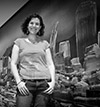 Liz Hickok (USA). artist working in photography, video, sculpture, and installation. Hickok received her Masters in Fine Arts from Mills College in Oakland, California. She earned a BFA and BA from the School of the Museum of Fine Arts and Tufts University in Boston, Massachusetts. Hickok lived and worked in Boston for over ten years before moving to the San Francisco Bay Area.
Liz Hickok (USA). artist working in photography, video, sculpture, and installation. Hickok received her Masters in Fine Arts from Mills College in Oakland, California. She earned a BFA and BA from the School of the Museum of Fine Arts and Tufts University in Boston, Massachusetts. Hickok lived and worked in Boston for over ten years before moving to the San Francisco Bay Area.
In my Ground Waters series I create miniature worlds where both natural and urban environments are overgrown by strange crystal formations. The colorful tableaux are playful in their materials, but they also allude to our environment being saturated by pollution.
I assemble and combine various elements, like a science experiment, and then I flood the scene with a liquid crystal solution. Over the course of a few hours, days, or weeks, the crystals re-form, permeating the small model. I enjoy the conflicting processes of control and lack thereof.




















 Liz Hickok (USA). artist working in photography, video, sculpture, and installation. Hickok received her Masters in Fine Arts from Mills College in Oakland, California. She earned a BFA and BA from the School of the Museum of Fine Arts and Tufts University in Boston, Massachusetts. Hickok lived and worked in Boston for over ten years before moving to the San Francisco Bay Area.
Liz Hickok (USA). artist working in photography, video, sculpture, and installation. Hickok received her Masters in Fine Arts from Mills College in Oakland, California. She earned a BFA and BA from the School of the Museum of Fine Arts and Tufts University in Boston, Massachusetts. Hickok lived and worked in Boston for over ten years before moving to the San Francisco Bay Area.Alejandro Malo
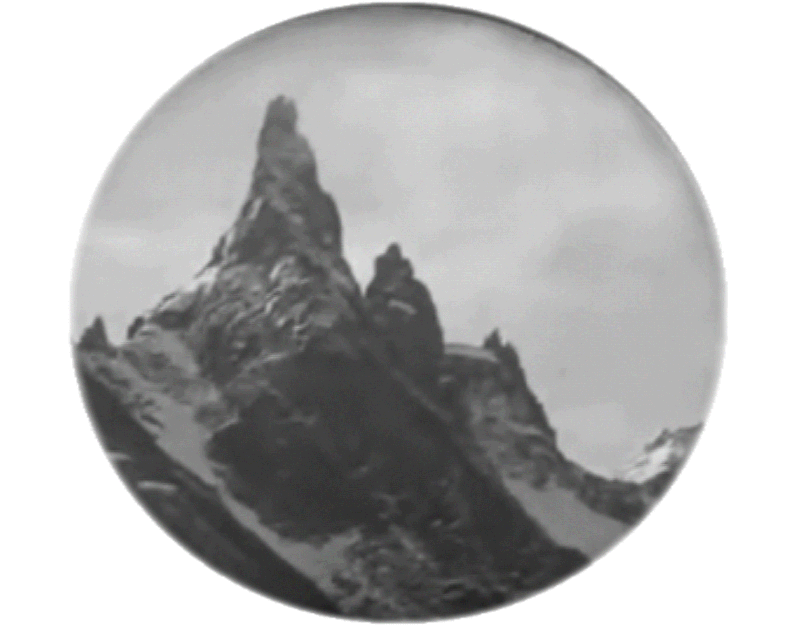
Cloud Phenomena of Maloja. Film by Arnold Fanck, 1924
Landscape, long before being image, was literature and longing. Since ancient times, almost every civilization led an educated class that longed to return to the simple life of the countryside, back to nature with its deeper order and less troubled appearance. In the West, despite its widespread tradition against the city life and akin to recover the rural simplicity, it is only during the Renaissance that the joy of those running away from the maddening crowds turns into the full enjoyment of nature, first in poetry and only afterwards as a growing presence in paintings. In the East, at least since China’s Tang Dynasty, a fertile dialogue is established around the landscape between poetry and painting, and the genre develops very soon and evolves in multiple aspects.
Centuries later, while other visual media were confronted by the emergence of photography to take in and emphasize the subjectivity of their gaze over this topic, photographic landscapes devote their attention to exoticism or the magnificence of natural views and offered a deceptive closeness to a naturalist interpretation. The romantic vision of nature took root strongly across images ranging from the Bisson brothers to Ansel Adams. In them, beauty was something external to be captured in each shot, a reserve where solitude was a regained innocence and open spaces offered an inexhaustible source of peacefulness for the contemplative eye under the changing light’s mantle.
Gradually, as these perspectives became advertising and marketing leitmotifs, this genre had to be reinvented and new possibilities sought elsewhere. Already in 1975, with the exhibition New Topographics: Photographs of a Man-Altered Landscape, it became clear that human intervention was inseparable from our new perception of landscape. The aseptic style of the authors gathered in this exhibition, considered almost forensic and where the emotional charge seemed absent, caused the sensation of being somehow close to a crime scene’s lingering memories, but devoid of its dramatic charge. During the following years, some authors, with a similar methodology but against this trend, looked after landscapes as representation of their own temperament, metaphor of an inner life that finds in the environment an affinity and a strong individual expressive capacity. Finally, photography assumed the same subjectivity of other means. As an example, Hiroshi Sugimoto wrote about his Seascapes: "Every time I view the sea, I feel a calming sense of security, as if visiting my ancestral home". In that phrase, anyone can guess a sort of poetic inclination and a strong artistic weight that facilitates dialogue with paintings, as was done in 2012 by exposing this series with Mark Rothko’s work.
However, Eden’s innocence became impossible in a world where human presence outreach tainted glaciers and forests with the same nonchalance. In the second half of the twentieth century, the landscape was transformed from man facing nature, to be a metaphor for our own humanity and, at the same time, scene of our fears, hopes and tragedies. We read as landscape every place where a scenario simulates an open space, no matter whether an emotional or conceptual projection of ourselves, but also we read it under the titanic action of mining, between the megalopolis’ streets or against the inventiveness of major transformation projects. Hybridization of genres has allowed the unreal calm of sensationalist scenes as in Fernando Brito’s pictures and the catastrophe of Chinese dumping sites of Yao Lu to be shown as images of bucolic appearance. We bit the fruit of our pride and today paradise is a shy promise. We need to build works, with concrete actions to transform the announced catastrophe in a redemptive epiphany. The landscape is, with its potential for imagination and denunciation, the much needed tool.
 Alejandro Malo (Mexico, 1972). Lives and works in Mexico and is the director of ZoneZero. Since 1993, he has taken part in various cultural projects and worked as an information technology consultant. He has collaborated in print and electronic publications, and given workshops and conferences on literature, creative writing, storytelling and technology. In 2009, Malo joined the team of the Fundación Pedro Meyer, where he directs the Archives and Technology departments.
Alejandro Malo (Mexico, 1972). Lives and works in Mexico and is the director of ZoneZero. Since 1993, he has taken part in various cultural projects and worked as an information technology consultant. He has collaborated in print and electronic publications, and given workshops and conferences on literature, creative writing, storytelling and technology. In 2009, Malo joined the team of the Fundación Pedro Meyer, where he directs the Archives and Technology departments.
Cloud Phenomena of Maloja. Film by Arnold Fanck, 1924
Landscape, long before being image, was literature and longing. Since ancient times, almost every civilization led an educated class that longed to return to the simple life of the countryside, back to nature with its deeper order and less troubled appearance. In the West, despite its widespread tradition against the city life and akin to recover the rural simplicity, it is only during the Renaissance that the joy of those running away from the maddening crowds turns into the full enjoyment of nature, first in poetry and only afterwards as a growing presence in paintings. In the East, at least since China’s Tang Dynasty, a fertile dialogue is established around the landscape between poetry and painting, and the genre develops very soon and evolves in multiple aspects.
Centuries later, while other visual media were confronted by the emergence of photography to take in and emphasize the subjectivity of their gaze over this topic, photographic landscapes devote their attention to exoticism or the magnificence of natural views and offered a deceptive closeness to a naturalist interpretation. The romantic vision of nature took root strongly across images ranging from the Bisson brothers to Ansel Adams. In them, beauty was something external to be captured in each shot, a reserve where solitude was a regained innocence and open spaces offered an inexhaustible source of peacefulness for the contemplative eye under the changing light’s mantle.
Gradually, as these perspectives became advertising and marketing leitmotifs, this genre had to be reinvented and new possibilities sought elsewhere. Already in 1975, with the exhibition New Topographics: Photographs of a Man-Altered Landscape, it became clear that human intervention was inseparable from our new perception of landscape. The aseptic style of the authors gathered in this exhibition, considered almost forensic and where the emotional charge seemed absent, caused the sensation of being somehow close to a crime scene’s lingering memories, but devoid of its dramatic charge. During the following years, some authors, with a similar methodology but against this trend, looked after landscapes as representation of their own temperament, metaphor of an inner life that finds in the environment an affinity and a strong individual expressive capacity. Finally, photography assumed the same subjectivity of other means. As an example, Hiroshi Sugimoto wrote about his Seascapes: "Every time I view the sea, I feel a calming sense of security, as if visiting my ancestral home". In that phrase, anyone can guess a sort of poetic inclination and a strong artistic weight that facilitates dialogue with paintings, as was done in 2012 by exposing this series with Mark Rothko’s work.
However, Eden’s innocence became impossible in a world where human presence outreach tainted glaciers and forests with the same nonchalance. In the second half of the twentieth century, the landscape was transformed from man facing nature, to be a metaphor for our own humanity and, at the same time, scene of our fears, hopes and tragedies. We read as landscape every place where a scenario simulates an open space, no matter whether an emotional or conceptual projection of ourselves, but also we read it under the titanic action of mining, between the megalopolis’ streets or against the inventiveness of major transformation projects. Hybridization of genres has allowed the unreal calm of sensationalist scenes as in Fernando Brito’s pictures and the catastrophe of Chinese dumping sites of Yao Lu to be shown as images of bucolic appearance. We bit the fruit of our pride and today paradise is a shy promise. We need to build works, with concrete actions to transform the announced catastrophe in a redemptive epiphany. The landscape is, with its potential for imagination and denunciation, the much needed tool.
 Alejandro Malo (Mexico, 1972). Lives and works in Mexico and is the director of ZoneZero. Since 1993, he has taken part in various cultural projects and worked as an information technology consultant. He has collaborated in print and electronic publications, and given workshops and conferences on literature, creative writing, storytelling and technology. In 2009, Malo joined the team of the Fundación Pedro Meyer, where he directs the Archives and Technology departments.
Alejandro Malo (Mexico, 1972). Lives and works in Mexico and is the director of ZoneZero. Since 1993, he has taken part in various cultural projects and worked as an information technology consultant. He has collaborated in print and electronic publications, and given workshops and conferences on literature, creative writing, storytelling and technology. In 2009, Malo joined the team of the Fundación Pedro Meyer, where he directs the Archives and Technology departments.Rebecca Reeve

The miracle of light pours over the green and brown expanse of saw grass and of water, shining and slowly moving, the grass and the water that is the meaning and the central fact of the Everglades. It is a river of grass. —Marjory Stoneman Douglas
I began this series during my AIRIE residency in the Everglades in December 2012. It draws inspiration from a ritual described in The Rings of Saturn by W.G. Sebald. In Holland in the 1600s, during the wake of the deceased, it was customary to cover all mirrors, landscape paintings and portraits in the home with cloths. It was believed this would make it easier for the soul to leave the body and subdue any temptations for it to stay in this world.
The ritual seemed, by extension, to be a confirmation of the deeply moving experience that one often feels in the natural environment, and thus provided both a literal and contextual frame within which to shoot the landscape, a portal from the domestic into the wilderness. The curtains, all purchased from Goodwill and Salvation Army stores in south Florida and Utah, represent a ‘social fabric’ with a history already attached to them. In our increasingly urban existence that ever distances us from the wilderness experience, the drapes serve as visual connectors to the familiar.
Images from the Marjory's World series will be on show in the exhibition 'Mise en Scene' opening March 16th at Hazan Projects in New York City.





















 Rebecca Reeve (England) She received her Bachelor of Fine Arts degree at Bath Spa University and a Masters of Visual Arts at the University of South Wales, Australia. Her photographs have been exhibited nationally and internationally including La Biennale de Montreal, (Canada), Freies Museum, Berlin, (Germany), Museum of Latin American Art, (Buenos Aires), EFA Project Space, (NYC) and the Masur Museum of Art, (Louisiana). In 2013 she was Artist in Residence at AIRIE and the recipient of the Artist in Exploration grant underwritten by Rolex. In 2016 she will be Artist in Residence at Joshua Tree National Park. She lives and works in New York City.
Rebecca Reeve (England) She received her Bachelor of Fine Arts degree at Bath Spa University and a Masters of Visual Arts at the University of South Wales, Australia. Her photographs have been exhibited nationally and internationally including La Biennale de Montreal, (Canada), Freies Museum, Berlin, (Germany), Museum of Latin American Art, (Buenos Aires), EFA Project Space, (NYC) and the Masur Museum of Art, (Louisiana). In 2013 she was Artist in Residence at AIRIE and the recipient of the Artist in Exploration grant underwritten by Rolex. In 2016 she will be Artist in Residence at Joshua Tree National Park. She lives and works in New York City.
The miracle of light pours over the green and brown expanse of saw grass and of water, shining and slowly moving, the grass and the water that is the meaning and the central fact of the Everglades. It is a river of grass. —Marjory Stoneman Douglas
I began this series during my AIRIE residency in the Everglades in December 2012. It draws inspiration from a ritual described in The Rings of Saturn by W.G. Sebald. In Holland in the 1600s, during the wake of the deceased, it was customary to cover all mirrors, landscape paintings and portraits in the home with cloths. It was believed this would make it easier for the soul to leave the body and subdue any temptations for it to stay in this world.
The ritual seemed, by extension, to be a confirmation of the deeply moving experience that one often feels in the natural environment, and thus provided both a literal and contextual frame within which to shoot the landscape, a portal from the domestic into the wilderness. The curtains, all purchased from Goodwill and Salvation Army stores in south Florida and Utah, represent a ‘social fabric’ with a history already attached to them. In our increasingly urban existence that ever distances us from the wilderness experience, the drapes serve as visual connectors to the familiar.
Images from the Marjory's World series will be on show in the exhibition 'Mise en Scene' opening March 16th at Hazan Projects in New York City.





















 Rebecca Reeve (England) She received her Bachelor of Fine Arts degree at Bath Spa University and a Masters of Visual Arts at the University of South Wales, Australia. Her photographs have been exhibited nationally and internationally including La Biennale de Montreal, (Canada), Freies Museum, Berlin, (Germany), Museum of Latin American Art, (Buenos Aires), EFA Project Space, (NYC) and the Masur Museum of Art, (Louisiana). In 2013 she was Artist in Residence at AIRIE and the recipient of the Artist in Exploration grant underwritten by Rolex. In 2016 she will be Artist in Residence at Joshua Tree National Park. She lives and works in New York City.
Rebecca Reeve (England) She received her Bachelor of Fine Arts degree at Bath Spa University and a Masters of Visual Arts at the University of South Wales, Australia. Her photographs have been exhibited nationally and internationally including La Biennale de Montreal, (Canada), Freies Museum, Berlin, (Germany), Museum of Latin American Art, (Buenos Aires), EFA Project Space, (NYC) and the Masur Museum of Art, (Louisiana). In 2013 she was Artist in Residence at AIRIE and the recipient of the Artist in Exploration grant underwritten by Rolex. In 2016 she will be Artist in Residence at Joshua Tree National Park. She lives and works in New York City.Jamey Stillings

We are at a critical juncture in the evolution of our species. How we choose to live on Earth in the next few decades, with a rapidly growing human population and expanding consumption patterns, may determine not only our prospects for survival, but also the ultimate viability of Earth’s ecosystem.
I have long been intrigued by the tension and visual energy created at the nexus of nature and human activity. Uniquely as a species, we modify and use the environment for our perceived needs or enjoyment. Sometimes we consider the future consequences of our actions. More often, we focus myopically on the short-term utility of land and resource use.
Changing Perspectives is the working title for a connected set of photography projects I will engage in over the next five years. Building upon The Evolution of Ivanpah Solar, a new project, Energy in the American West, will expand my examination of utility-scale renewable energy projects in the United States, while selectively documenting domestic coal, oil, and natural gas energy production.
My primary goal, however, is to develop Changing Perspectives into a project of global scale. New renewable energy capacity is being built around the world at a remarkable pace. Projects, in many countries, on several continents, reflect a growing international commitment to transform our cultures and economies away from a dependence on fossil fuels towards a future that taps the extraordinary sustainable energy of the sun, wind, and tides. I will research and document a select group of renewable energy projects, ones that reflect a proactive commitment to future generations, while also striving to reveal the challenges and compromises such transformations frequently entail.






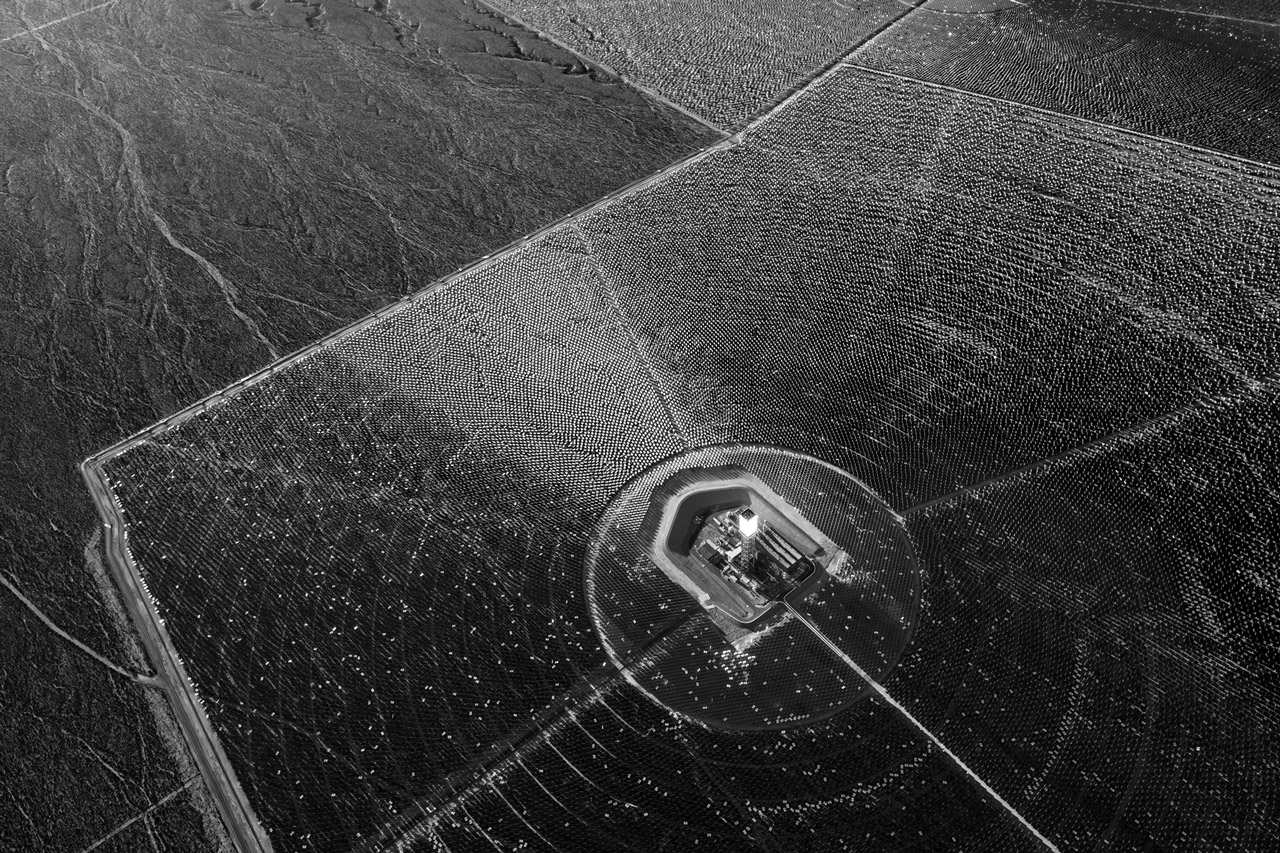










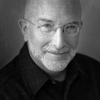 Jamey Stillings' career spans documentary, fine art and commercial assignment projects. He earned a BA in Art from Willamette University, an MFA in Photography from Rochester Institute of Technology, and has a diverse range of national and international commission clients. Stillings' work is in the collections of the United States Library of Congress, the Museum of Fine Arts, Houston, the Los Angeles County Museum of Art, the Nevada Museum of Art, and several private collections.
Jamey Stillings' career spans documentary, fine art and commercial assignment projects. He earned a BA in Art from Willamette University, an MFA in Photography from Rochester Institute of Technology, and has a diverse range of national and international commission clients. Stillings' work is in the collections of the United States Library of Congress, the Museum of Fine Arts, Houston, the Los Angeles County Museum of Art, the Nevada Museum of Art, and several private collections.
We are at a critical juncture in the evolution of our species. How we choose to live on Earth in the next few decades, with a rapidly growing human population and expanding consumption patterns, may determine not only our prospects for survival, but also the ultimate viability of Earth’s ecosystem.
I have long been intrigued by the tension and visual energy created at the nexus of nature and human activity. Uniquely as a species, we modify and use the environment for our perceived needs or enjoyment. Sometimes we consider the future consequences of our actions. More often, we focus myopically on the short-term utility of land and resource use.
Changing Perspectives is the working title for a connected set of photography projects I will engage in over the next five years. Building upon The Evolution of Ivanpah Solar, a new project, Energy in the American West, will expand my examination of utility-scale renewable energy projects in the United States, while selectively documenting domestic coal, oil, and natural gas energy production.
My primary goal, however, is to develop Changing Perspectives into a project of global scale. New renewable energy capacity is being built around the world at a remarkable pace. Projects, in many countries, on several continents, reflect a growing international commitment to transform our cultures and economies away from a dependence on fossil fuels towards a future that taps the extraordinary sustainable energy of the sun, wind, and tides. I will research and document a select group of renewable energy projects, ones that reflect a proactive commitment to future generations, while also striving to reveal the challenges and compromises such transformations frequently entail.

















 Jamey Stillings' career spans documentary, fine art and commercial assignment projects. He earned a BA in Art from Willamette University, an MFA in Photography from Rochester Institute of Technology, and has a diverse range of national and international commission clients. Stillings' work is in the collections of the United States Library of Congress, the Museum of Fine Arts, Houston, the Los Angeles County Museum of Art, the Nevada Museum of Art, and several private collections.
Jamey Stillings' career spans documentary, fine art and commercial assignment projects. He earned a BA in Art from Willamette University, an MFA in Photography from Rochester Institute of Technology, and has a diverse range of national and international commission clients. Stillings' work is in the collections of the United States Library of Congress, the Museum of Fine Arts, Houston, the Los Angeles County Museum of Art, the Nevada Museum of Art, and several private collections.Abelardo Morell

Since 1991 I have converted rooms into Camera Obscuras in order to photograph the strange and delightful meeting of the outside world with the room’s interior.
In an effort to find new ways to use this technique, I have worked with my assistant, C.J. Heyliger, on designing a light proof tent which can project views of the surrounding landscape, via periscope type optics, onto the surface of the ground inside the tent. Inside this space I photograph the sandwich of these two outdoor realities meeting on the ground. Depending on the quality of the surface, these views can take on a variety of painterly effects. The added use of digital technology on my camera lets me record visual moments in a much shorter time frame– for instance I can now get clouds and people to show up in some of the photographs.
This way of observing the landscape with specially equipped tents was practiced by some artists in the 19th century in order to trace on paper what they saw in the landscape. Interestingly, this approach to picturing the land was done even before the invention of photography.
















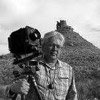 Abelardo Morell (Cuba, 1948). He immigrated to the United States with his parents in 1962. Morell received his undergraduate degree in 1977 from Bowdoin College and an MFA from The Yale University School of Art in 1981. In 1997 he received an honorary degree from Bowdoin College. His work has been collected and shown in many galleries, institutions and museums.
Abelardo Morell (Cuba, 1948). He immigrated to the United States with his parents in 1962. Morell received his undergraduate degree in 1977 from Bowdoin College and an MFA from The Yale University School of Art in 1981. In 1997 he received an honorary degree from Bowdoin College. His work has been collected and shown in many galleries, institutions and museums.
Since 1991 I have converted rooms into Camera Obscuras in order to photograph the strange and delightful meeting of the outside world with the room’s interior.
In an effort to find new ways to use this technique, I have worked with my assistant, C.J. Heyliger, on designing a light proof tent which can project views of the surrounding landscape, via periscope type optics, onto the surface of the ground inside the tent. Inside this space I photograph the sandwich of these two outdoor realities meeting on the ground. Depending on the quality of the surface, these views can take on a variety of painterly effects. The added use of digital technology on my camera lets me record visual moments in a much shorter time frame– for instance I can now get clouds and people to show up in some of the photographs.
This way of observing the landscape with specially equipped tents was practiced by some artists in the 19th century in order to trace on paper what they saw in the landscape. Interestingly, this approach to picturing the land was done even before the invention of photography.
















 Abelardo Morell (Cuba, 1948). He immigrated to the United States with his parents in 1962. Morell received his undergraduate degree in 1977 from Bowdoin College and an MFA from The Yale University School of Art in 1981. In 1997 he received an honorary degree from Bowdoin College. His work has been collected and shown in many galleries, institutions and museums.
Abelardo Morell (Cuba, 1948). He immigrated to the United States with his parents in 1962. Morell received his undergraduate degree in 1977 from Bowdoin College and an MFA from The Yale University School of Art in 1981. In 1997 he received an honorary degree from Bowdoin College. His work has been collected and shown in many galleries, institutions and museums.Peter Steinhauer

Since 1993, Peter Steinhauer has been documenting the many facets of Asian culture.
Upon his first visit to Hong Kong in January of 1994, arriving at the old Kai Tak International Airport, Steinhauer noticed a very large structure that was caged in bamboo and swathed in yellow material. He was amazed by this monumental structure, standing out beneath a canopy of clouds as it glowed against the monochromatic, urban skyline. Thus began Steinhauers fascination with these multicolored structures.
Once a practice throughout Asia, Hong Kong is the final stronghold of the bamboo scaffolders. The title Cocoon for this body of work was a natural choice. The framework; a metamorphosis; like caterpillars to butterflies. Colored material unveiled ceremoniously reveals a brand new façade, as in a cocoon revealing itself for the first time.



















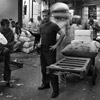 Peter Steinhauer (United States, 1966). Artist photographer who has been living and working un Asia since 1993. His photography focuses on architecture within urban landscape, natural landscape, Asian faces and man made structure. He is a recipient of numerous international photography awards including a finalist for the 2014 Lucie Awards, Ford Foundation grant for his multi year work in Viernam, Black and White Spider Award for Architecture, IPA and PX3 Paris awards, among others. He is also a member of the elite Explorers Club in New York.
Peter Steinhauer (United States, 1966). Artist photographer who has been living and working un Asia since 1993. His photography focuses on architecture within urban landscape, natural landscape, Asian faces and man made structure. He is a recipient of numerous international photography awards including a finalist for the 2014 Lucie Awards, Ford Foundation grant for his multi year work in Viernam, Black and White Spider Award for Architecture, IPA and PX3 Paris awards, among others. He is also a member of the elite Explorers Club in New York.
Since 1993, Peter Steinhauer has been documenting the many facets of Asian culture.
Upon his first visit to Hong Kong in January of 1994, arriving at the old Kai Tak International Airport, Steinhauer noticed a very large structure that was caged in bamboo and swathed in yellow material. He was amazed by this monumental structure, standing out beneath a canopy of clouds as it glowed against the monochromatic, urban skyline. Thus began Steinhauers fascination with these multicolored structures.
Once a practice throughout Asia, Hong Kong is the final stronghold of the bamboo scaffolders. The title Cocoon for this body of work was a natural choice. The framework; a metamorphosis; like caterpillars to butterflies. Colored material unveiled ceremoniously reveals a brand new façade, as in a cocoon revealing itself for the first time.



















 Peter Steinhauer (United States, 1966). Artist photographer who has been living and working un Asia since 1993. His photography focuses on architecture within urban landscape, natural landscape, Asian faces and man made structure. He is a recipient of numerous international photography awards including a finalist for the 2014 Lucie Awards, Ford Foundation grant for his multi year work in Viernam, Black and White Spider Award for Architecture, IPA and PX3 Paris awards, among others. He is also a member of the elite Explorers Club in New York.
Peter Steinhauer (United States, 1966). Artist photographer who has been living and working un Asia since 1993. His photography focuses on architecture within urban landscape, natural landscape, Asian faces and man made structure. He is a recipient of numerous international photography awards including a finalist for the 2014 Lucie Awards, Ford Foundation grant for his multi year work in Viernam, Black and White Spider Award for Architecture, IPA and PX3 Paris awards, among others. He is also a member of the elite Explorers Club in New York.

